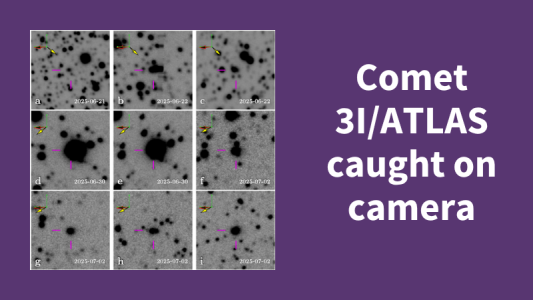Comet 3I/ATLAS caught on Rubin camera
Published 4 August 2025

Gallery of serendipitous observations of 3I/ATLAS from the NSF-DOE Vera C. Rubin Observatory.
The 7 billion-year-old interstellar object Comet 3I/ATLAS was discovered by Asteroid Terrestrial-impact Last Alert System (ATLAS) on 1 July 2025. In a happy coincidence, the Rubin telescope was collecting images of the part of the sky inhabited by the comet from 21 June to 7 July 2025 as part of its commissioning phase.
Dr Meg Schwamb is co-chair of the LSST Solar System Science Collaboration; in an interview on Radio 4's Today programme on 2 July 2025, she explained that it was a case of the telescope being in "the right place at the right time". Describing the visiting comet, Dr Schwamb, who is based at the Astrophysics Research Centre, Queen’s University Belfast, said: "It looks like a normal comet that would be in our solar system but it was moving much faster, on a trajectory outside of our solar system."
The early glimpse of the visiting Comet 3I/ATLAS – before it was discovered by the ATLAS telescope – is a hint to how the Rubin Observatory will contribute to our greater understanding of the Universe. "We need all these different telescopes looking at this object to understand what it's doing," said Dr Schwamb. "We want to see how this object evolves as it enters our solar system."
The Sorcha simulation software, developed by a team led by Dr Schwamb, suggests that there will be more opportunities for Rubin to capture the comet during August 2025.
A new paper, NSF-DOE Vera C. Rubin Observatory Observations of Interstellar Comet 3I/ATLAS (C/2025 N1), published on arXiv, reports on the observation and measurement of astrometry, photometry, morphology, and activity of 3I/ATLAS.
To hear Dr Schwamb's interview on the Today Programme, go to 24.00.